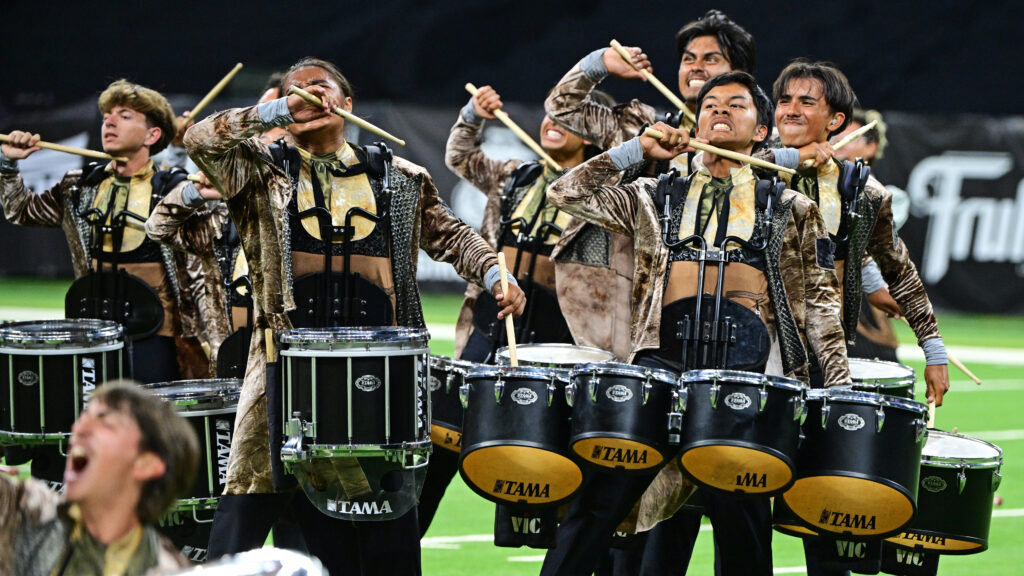From the 2004 DCI program book:
Drum Corps fans often ask “Why did corps A not place higher than corps B?”
What might seem obvious on the surface may be masked by the complexity of our judging system, which takes into account the entire process of creativity of the program and the performers who bring the show to life.
Possible points
General Effect 40
Visual Effect 20
Music Effect 20
Visual — 30
(each 20-point subcaption is divided by two)
Performance visual — 20
Ensemble visual — 20
Auxiliary — 20
Music – 30
(each 20-point subcaption is divided by two)
Ensemble brass — 20
Performance brass — 20
Performance percussion 1 — 20 Drum corps competition demands excellence from both the performers and the adjudicators.
The DCI judging philosophy is that any group could win at any contest. The judges’ decisions are based on the performances they observe and not on a corps’ reputation or past performances. The group that creates and recreates the best program will always come out on top.
Our judges evaluate four separate music captions: Music effect, ensemble music, brass performance and percussion performance. There are also four separate visual captions: Visual effect, ensemble visual, visual performance and color guard. The following is a summary of the Drum Corps International judging system with examples of how it works.
Performance The two music performance captions — percussion performance and brass performance — and the visual performance caption concentrate on the individual performer. The judge examines the students’ work at close range on the field. In evaluating the music performance captions, a judge will concentrate on the quality of musicianship and the quality of technique (excellence). How well the individual musicians play will determine the overall score for each brass or percussion line.
Judges will “sample” individual musicians as they play and march through the program, listening for the musical aspects that are positive as well as the ones that need improvement. The judge further applies his/her knowledge to assist the corps in improving their work. Additionally, a judge must recognize “simultaneous responsibilities,” which means: “How well are the musicians playing their music within the spectrum of visual and musical demands?” Visual performance is much the same as the music performance captions with further consideration being given to the control of the performer’s body while they play and manipulate their equipment.
Additionally, a visual judge will examine the methodology of movement and basic alignment between performers in two sub-captions called accuracy and technique. The same recognition of achievement and encouragement for improvement is applied in the visual performance caption as in music.
Ensemble Ensemble judges further examine music and visual elements in detail from a distance, usually in the press box of a stadium. They take a look at the big picture but still focus on either a musical or visual section of the corps. Within the ensemble music caption, a judge concentrates on the musicality of the group. Consideration is given to the tuning of the ensemble, balance between brass and percussion, tempo control and rhythmic accuracy.
Effective musicianship judging requires a deep understanding of the elements of music and how they interact, as well as a detailed analysis of the musical rendering offered by the corps. Style also becomes an issue when judging ensemble and the adjudicators must recognize the efforts of the corps regardless of their chosen genre of music. All performers must interpret the music in a similar fashion. Sometimes the judge may find that the brass or percussion work at cross-purposes in their interpretation.
The judge will indicate this to the performers and offer suggestions for improvement. Like the music ensemble judge, the visual ensemble judge addresses the big picture. He/she examines the whole form and looks for accuracy in alignment and balance within, across and between forms. One slight difference, although it is somewhat related to style in music, is that the visual ensemble judge is considering the compositional elements of program.
Here, some may say, judges are rewarding the designers, however, they respond similarly in music. If no opportunity for expression and interpretation existed, or the music/visual was all in one mode of presentation without much variety/creativity, the results would be very basic and one-dimensional. The performers would not be able to communicate very well. The ensemble visual judge also examines the musical interpretation through the visual design.
Here again the judge is required to consider “simultaneous responsibilities.” Consideration is given to the performers’ body and equipment control while presenting the development of the form. Successful corps do not simply create big, well-balanced pictures. The truly successful corps are the ones who get to these pictures without the audience realizing how they did it. They move in and out of their design effortlessly and transition from form to form or to a new piece of equipment, flag or prop effortlessly.
The most successful corps make their music sound and visual design look effortless when it is actually quite difficult.
Color guard The addition of the color guard sheet four years ago recognized a unique ensemble of performers who were previously overlooked in the former judging systems. These young men and women are the personality of many of the competing units. Their use of mime, interpretive dance and movement not to mention some pretty amazing coordination while spinning a flag, tossing a rifle or sabre can enhance the overall program. Color guard can also be the center of a very special moment in the design. Judges recognize the facility, training, excellence and precision of these performers. They must further evaluate the logic of the guard’s design and their musical interpretation.
Effect The most global area of evaluation is known as effect. Music and visual presentations should create an effect unto themselves, triggering aesthetic responses to the intellectual and emotional design and performance. In essence, this is how we determine what is entertaining about a particular program. Effect captions are the most subjective to judge and yet there are established principles of design and performance practices which can determine what is effective. Effect judges are looking at the actual design of the show, the peaks and valleys of excitement throughout, and how the performers make the show successful.
Questions a judge might consider in judging effect are: Do all of the elements of visual and musical design reach an effective climax together? Are there a variety of effects in the show that display a wide array of human emotions? Does the pacing of the show vary, remain steady, or have lapses? It is important to realize that it is not just the designers who control the effect but also the performers who bring the effects to life.
The performers may be truly amazing musicians and superb marchers, yet they may have limited show material to work with. Eventually the effect wears thin. To be a good effect judge, one must have a depth of understanding of how shows are put together and how performers can not only interpret the design but also actually elevate its success.
Conclusion In conclusion, fans should note that the Drum Corps International member corps creates the judging system. Each year instructors and the designers in the activity meet to present their views about how this system should be interpreted refined and/or revised. This is where the current philosophy of judging originates. The philosophy is then further developed and delivered as a curriculum to the judges who in turn put the system into practice during the competitive season.
While the DCI judge makes an individual determination of placement and score, he/she is doing so with a significant amount of knowledge about how the system works and with the support of various tools to help make an informed and informative judgment.
Judge administration team
John Phillips — Judge administrator
Marie Czapinski — Visual caption chair
Glen Fugett — percussion caption chair
Andrew Poor — Brass caption chair
Gary Markham — Music education director
George Oliviero – Visual education director





